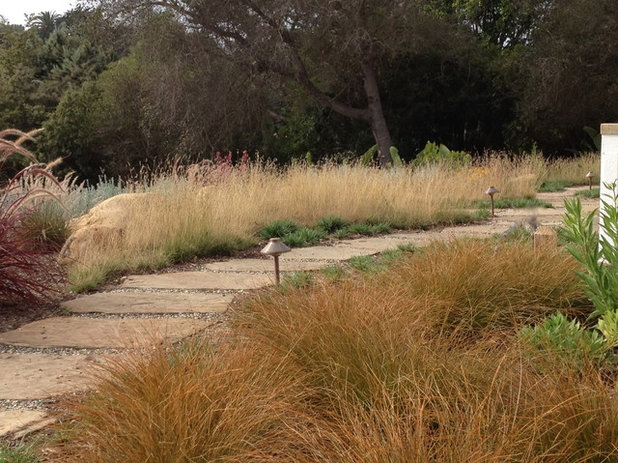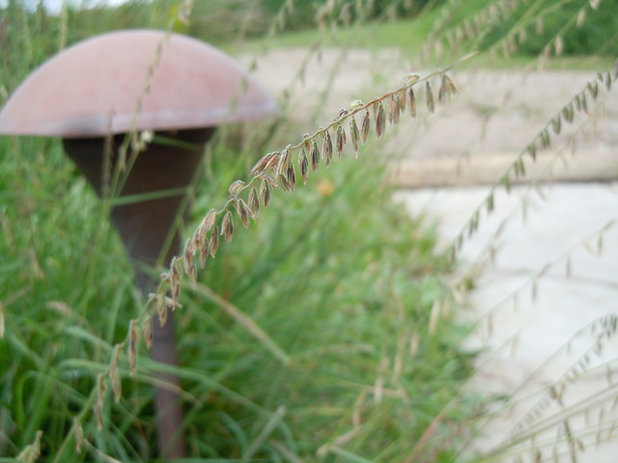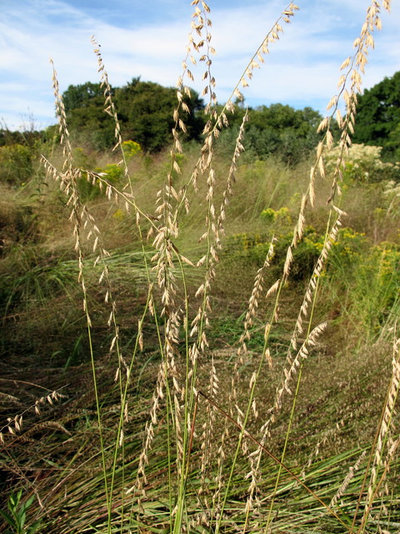A garden that supports lots of wildlife is thick with plants at every layer, from the surface up to flowers, shrubs and trees. Sideoats grama (
Bouteloua curtipendula) makes a great base for any sunny and dry garden bed. This is one grass I try to use often in my design work, simply because it looks great in any season and is perfect for creating a thick, healthy level of undergrowth among flowering perennials.
I’ve highlighted several of the most stalwart native grasses lately, like prairie dropseed (
Sporobolus heterolepis), blue grama (
Bouteloua gracilis) and more. Truth is, North America has an embarrassment of riches when it comes to unique and tough grasses, and sideoats grama is one of them.

Pat Brodie Landscape Design
Botanical name: Bouteloua curtipendulaCommon name: Sideoats grama
Origin: Native everywhere in the U.S. but in Oregon, Washington, Idaho and New England; especially prevalent in the Great Plains from the Mississippi River to the Rockies
Where it will grow: Hardy to -40 degrees Fahrenheit (USDA zones 3 to 9; find your zone)
Water requirement: Dry to medium moisture
Light requirement: Full sun
Mature size: 12- to 18-inch-tall foliage; 2 to 3 feet tall when in bloom, and about 12 to 18 inches wide
Benefits and tolerances: Does great in dry, well-drained soils, from clay to sandy to slightly rocky
Seasonal interest: Blooms are moderately ornamental; seeds are highly ornamental; strong upright winter presence
When to plant: Potted or bare-root plants can be put in from late spring to early fall.

anne houser//dropseed studio//kinghorn gardens
Distinguishing traits. Two things make sideoats grama stand out as an ornamental grass. First, its flowers have a subtle but bright pink to orange to purple inflorescence. Second, once the seed heads develop, they are quite pronounced and unique as they rise above the foliage, emerging from the side of the stalk. What’s more, birds like eating the seeds.
How to use it. Drifts and masses among native flowers are perfect, letting the low grass act as a low-maintenance green mulch in place of wood chips or bark. It’s a great habitat for hiding songbirds in both winter and summer. It’s also nifty all by itself in large, modernistic swaths, and it provides some degree of fall color, from light orange to bright tan.
 Planting notes.
Planting notes. Plant sideoats grama in full sun in a medium-moisture to dry soil. It does fine in clay, sand or rocky conditions. It’s a very slow spreader — much more of a clumping shortgrass.
As a warm-season native grass, it won’t emerge until late spring but will quickly grow once the early summer heat arrives. Sideoats grama is easy to grow from seed, too.
Photo by Kristine Paulus





